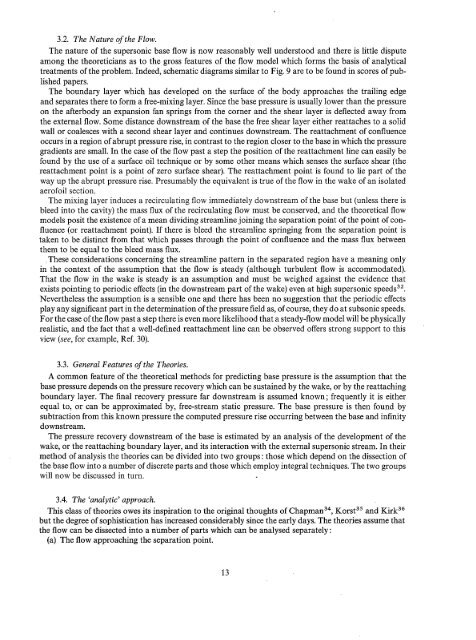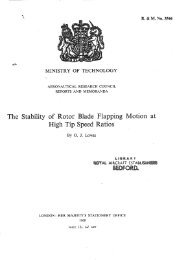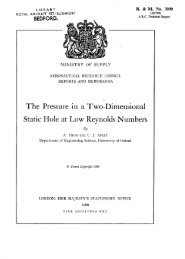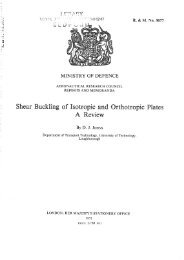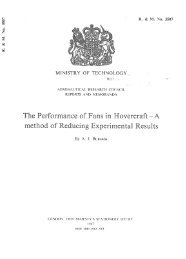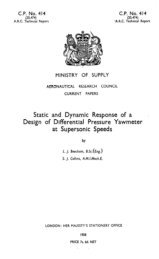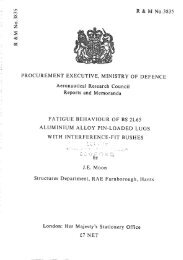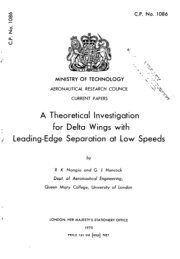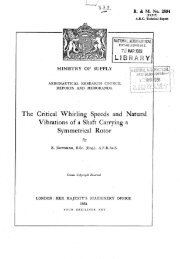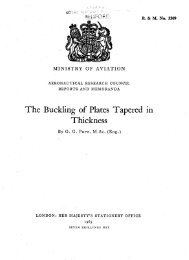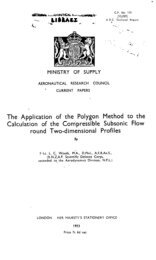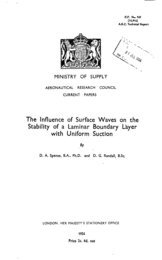A Discussion of Two-Dimensional Turbulent Base Flows - aerade
A Discussion of Two-Dimensional Turbulent Base Flows - aerade
A Discussion of Two-Dimensional Turbulent Base Flows - aerade
You also want an ePaper? Increase the reach of your titles
YUMPU automatically turns print PDFs into web optimized ePapers that Google loves.
3.2. The Nature <strong>of</strong> the Flow.<br />
The nature <strong>of</strong> the supersonic base flow is now reasonably well understood and there is little dispute<br />
among the theoreticians as to the gross features <strong>of</strong> the flow model which forms the basis <strong>of</strong> analytical<br />
treatments <strong>of</strong> the problem. Indeed, schematic diagrams similar to Fig. 9 are to be found in scores <strong>of</strong> pub-<br />
lished papers.<br />
The boundary layer which has developed on the surface <strong>of</strong> the body approaches the trailing edge<br />
and separates there to form a free-mixing layer. Since the base pressure is usually lower than the pressure<br />
on the afterbody an expansion fan springs from the corner and the shear layer is deflected away from<br />
the external flow. Some distance downstream <strong>of</strong> the base the free shear layer either reattaches to a solid<br />
wall or coalesces with a second shear layer and continues downstream. The reattachment <strong>of</strong> confluence<br />
occurs in a region <strong>of</strong> abrupt pressure rise, in contrast to the region closer to the base in which the pressure<br />
gradients are small. In the case <strong>of</strong> the flow past a step the position <strong>of</strong> the reattachment line can easily be<br />
found by the use <strong>of</strong> a surface oil technique or by some other means which senses the surface shear (the<br />
reattachment point is a point <strong>of</strong> zero surface shear). The reattachment point is found to lie part <strong>of</strong> the<br />
way up the abrupt pressure rise. Presumably the equivalent is true <strong>of</strong> the flow in the wake <strong>of</strong> an isolated<br />
aer<strong>of</strong>oil section.<br />
The mixing layer induces a recirculating flow immediately downstream <strong>of</strong> the base but (unless there is<br />
bleed into the cavity) the mass flux <strong>of</strong> the recirculating flow must be conserved, and the theoretical flow<br />
models posit the existence <strong>of</strong> a mean dividing streamline joining the separation point <strong>of</strong> the point <strong>of</strong> con-<br />
fluence (or reattachment point). If there is bleed the streamline springing from the separation point is<br />
taken to be distinct from that which passes through the point <strong>of</strong> confluence and the mass flux between<br />
them to be equal to the bleed mass flux.<br />
, These considerations concerning the streamline pattern in the separated region have a meaning only<br />
in the context <strong>of</strong> the assumption that the flow is steady (although turbulent flow is accommodated).<br />
That the flow in the wake is steady is an assumption and must be weighed against the evidence that<br />
exists pointing to periodic effects (in the downstream part <strong>of</strong> the wake) even at high supersonic speeds a2.<br />
Nevertheless the assumption is a sensible one and there has been no suggestion that the periodic effects<br />
play any significant part in the determination <strong>of</strong> the pressure field as, <strong>of</strong> course, they do at subsonic speeds.<br />
For the case <strong>of</strong> the flow past a step there is even more likelihood that a steady-flow model will be physically<br />
realistic, and the fact that a well-defined reattachment line can be observed <strong>of</strong>fers strong support to this<br />
view (see, for example, Ref. 30).<br />
3.3. General Features <strong>of</strong> the Theories.<br />
A common feature <strong>of</strong> the theoretical methods for predicting base pressure is the assumption that the<br />
base pressure.depends on the pressure recovery which can be sustained by the wake, or by the reattaching<br />
boundary layer. The final recovery pressure far downstream is assumed known; frequently it is either<br />
equal to, or can be approximated by, free-stream static pressure. The base pressure is then found by<br />
subtraction from this known pressure the computed pressure rise occurring between the base and infinity<br />
downstream.<br />
The pressure recovery downstream <strong>of</strong> the base is estimated by an analysis <strong>of</strong> the development <strong>of</strong> the<br />
wake, or the reattaching boundary layer, and its interaction with the external supersonic stream. In their<br />
method <strong>of</strong> analysis the theories can be divided into two groups : those which depend on the dissection <strong>of</strong><br />
the base flow into a number <strong>of</strong> discrete parts and those which employ integral techniques. The two groups<br />
will now be discussed in turn.<br />
3.4. The 'analytic" approach.<br />
This class <strong>of</strong> theories owes its inspiration to the original thoughts <strong>of</strong> Chapman a4, Korst a5 and Kirk a 6<br />
but the degree <strong>of</strong> sophistication tias increased considerably since the early days. The theories assume that<br />
the flow can be dissected into a niamber <strong>of</strong> parts which can be analysed separately:<br />
(a) The flow approaching the separation point.<br />
13


